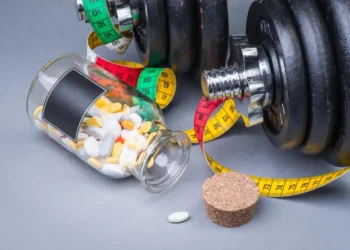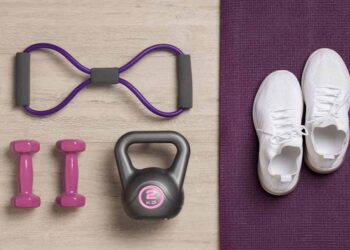Did you know that adding stretches to your workouts can help a lot? It boosts your muscle recovery and makes you perform better. This is great for athletes, people lifting weights, or anyone who likes to exercise. Stretching right helps lower muscle soreness, makes you more flexible, and helps you heal faster.
We’ll talk about various types of stretches and how they help muscles recover. This includes stretches that make you more flexible and ones that boost performance. We’ll share how to fit stretching into your daily routine. So, get set to stretch and see a faster recovery. Plus, you’ll open the door to reaching your full athletic power!
Different Types of Stretches
Adding different stretches to your exercise can help your muscles recover and get more flexible. It’s good to know the types, like static, dynamic, and others. This way, you can choose what’s best for you.
Static Stretches:
Static stretches are about holding a stretch for 15-30 seconds to make your muscles longer and looser. This helps make you more flexible and cuts down on injuries. But, remember, doing big static stretches before you work out can make your muscles less powerful. So, it’s best to save them for after exercise, as part of your cool-down.
Dynamic Stretching:
Dynamic stretching means moving as you stretch, like getting ready for your sport or activity. It’s great for warming up your muscles, boosting blood flow, and making your joints move better. Using dynamic stretching before you get active helps your workout or game go smoothly.
Ballistic Stretches:
Ballistic stretches are quick movements to stretch your muscles really far. They can be risky because of the fast, hard motions. For most people, including those without special training, it’s best to avoid these due to the chance of injury.
Proprioceptive Neuromuscular Facilitation (PNF) Stretching:
PNF stretching is a bit more complex. You tighten the muscle first, then slowly stretch it more, before relaxing. This stretching is very good for getting more flexible and relaxing your muscles. It’s recommended to do PNF stretches after your main exercises to improve muscle length.
Learning about these stretching methods lets you pick the best ones for muscle recovery and peak performance.
| Type of Stretch | Purpose | Timing |
|---|---|---|
| Static Stretches | Promote flexibility and reduce the risk of injury | Performed after workouts |
| Dynamic Stretching | Warm up muscles and improve joint mobility | Performed before workouts |
| Ballistic Stretches | Not recommended due to high risk of injury | N/A |
| PNF Stretching | Improve flexibility and relax muscles | Performed after exercises |
The Benefits of Stretching
Stretching is great for both weightlifters and athletes. Adding regular stretches to your workouts helps your muscles recover faster. It also boosts muscle health, flexibility, and avoids injuries.
Stretching after a workout helps your muscles heal better. It brings more blood to the muscles, feeding them with vital nutrients and oxygen. This way, your muscles don’t feel sore like they usually do after a tough session.
Becoming more flexible is key for athletic success. By stretching often, you broaden your muscles’ movement ability. This not only helps with healing but also makes lifting weights easier and safer.
Preventing injuries is a big part of why stretching is important. It keeps your body ready for all sorts of movements, lowering the chance of getting hurt. Stretching also keeps your muscles balanced, lowering the injury risk further.
But what if you’re already hurt? Stretching can still help. It relaxes the muscles near the injury and brings more blood to help it heal. This makes the healing faster and can stop scar tissue from forming.
Stretching does more than help you heal and not get hurt. It makes you more flexible, so you can move better in daily life and sports. This cuts down on effort too.
Plus, it can make your posture better. Stretching out tight spots and strengthening others can improve how you stand and sit. This also helps your blood flow well throughout your whole body.
In short, adding stretch routines to your workout does a lot of good. It’s great for muscle health, flexibility, injury safety, recovery, and posture. So, make stretching a regular part of your exercise to be at your best, stay safe, and feel great.
Key Takeaways: How to Improve Your Muscle Recovery and Performance with Stretching
Adding stretching to your fitness plan is key for better muscle recovery. Before you start working out, do dynamic stretching. After exercising, do a stretching routine. This will ease muscle soreness and boost flexibility.
Dynamic stretching gets your muscles ready by moving them through their full range. It makes your performance better. These stretches get more blood to your muscles, helping you get ready for your workout.
Static stretching, where you hold a pose, can be bad before you exercise. It makes your muscles too loose and could lead to injury. After your workout, static stretching helps your muscles recover and stay flexible.
For increased joint movement, start mobility exercises with static stretches. This way, you can focus on getting certain muscles and joints really moving.
Choosing the right stretches is important to avoid getting hurt and help your muscles heal. If you stretch regularly as part of your workout plan, you’ll perform better and feel less sore.
Benefits of Dynamic Stretching
Dynamic stretching has a lot of pluses for muscle health and performance:
- Gets more blood to your muscles, bringing in nutrients and oxygen.
- Makes your muscles warmer, which makes them more flexible and cuts injury chances.
- Wakes up the muscles you’re going to use, which makes your workout better.
- Increases how far you can move and your joint flexibility.
Doing dynamic stretches before workout helps your body get set. It boosts recovery and lifts your athletic output.
Recovery strategies for athletes
Athletes bounce back from muscle strain using smart methods. One top plan is R.I.C.E. This stands for rest, ice, compression, and elevation. It’s great for reducing pain, swelling, and aiding healing.
Rest is key for muscle recovery. Listen to your body. Avoid doing things that hurt or make it worse. Rest helps your muscles get better.
Ice is a big help too. It lowers pain and swelling. Icing the area shrinks blood vessels, which controls fluid flow and cuts down on swelling.
Compression wraps can also be useful. They help muscles heal by lowering swelling. Make sure they fit snug but not too tight. This helps blood move well.
Elevating an injured muscle above heart level is smart. It pulls fluid away, lowering swelling. This means less pressure and pain, which helps recovery.
A rich-protein diet boosts recovery even more. Proteins aid in fixing muscles. Good sources include meats, beans, and tofu. They help build back strong muscles.
Getting advice from a physical therapist is also wise. They offer exercises and a plan just for you. This speeds up healing and makes it safer.
In short, follow R.I.C.E. for muscle strain recovery. Eat plenty of proteins. And get help from a therapist. These steps make sure athletes come back healthier and stronger.
The Importance of Proper Recovery for Athletic Performance
Proper recovery helps athletes perform their best and stay safe. When you’re tired, everything suffers. Your muscles, brain, and willpower all slow down. This can lead to bad decisions, low motivation, and trouble focusing. Not taking enough time to recover means more chances of getting hurt. It also stops athletes from doing their very best.
Athletes should make rest and recovery a top priority. Resting allows the body to heal and get stronger. It boosts energy, lowers swelling, and balances hormones. It also refreshes the mind and helps repair any damage. This way, athletes can perform better, avoid tiredness, and prevent injuries.
Good recovery plans have rest days and enough time for sleep. Sleep is key for the body to recover fully. It helps balance hormones, repairs tissues, and even improves memory and learning.
What you eat and drink is also important for recovery. A healthy diet with the right kinds of food helps muscles grow and heal. Staying hydrated is vital for peak performance and recovery.
Dealing with mental tiredness is just as crucial. Relaxation methods like meditation and deep breathing can really help. Doing activities that make you happy also recharges your mind. This keeps athletes sharp during training and competitions.
In summary, proper recovery is vital for top athletic performance. It means dealing with physical and mental tiredness. This includes rest, sleep, good food, and strong mental habits. By following these steps, athletes can boost their performance, stay safe, and reach their goals.
Conclusion
Stretching plays a big part in muscle recovery and fighting fatigue. It helps improve your flexibility, motion, and blood flow. This leads to quicker healing and less sore muscles.
Athletes should make stretching a key part of their recovery. It’s important for anyone looking to be at their best. Regular stretching helps your body recover and perform better.
Make sure to stretch every day, before and after being active. It gets your muscles ready and helps them recover later. By stretching regularly, you will see great changes in how quickly you recover and perform.














